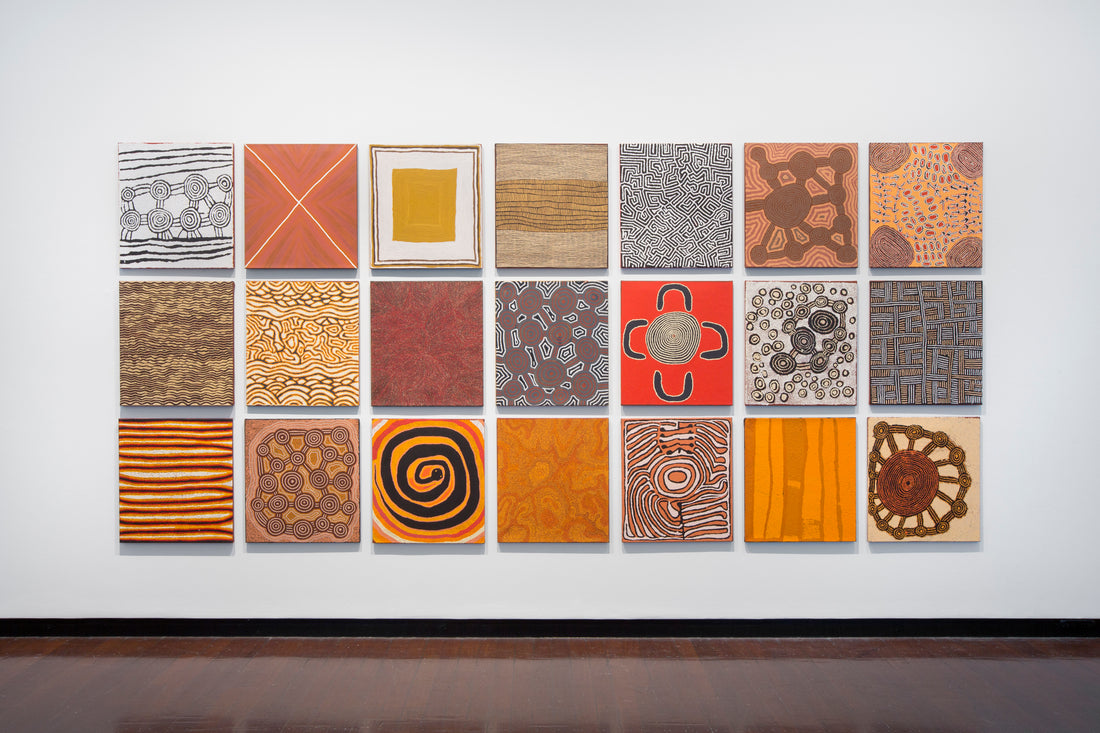Pintupi Way
27 October-17th December 2023
This is an outstanding collection of works curated by Christopher Hodgers that celebrates the history and brilliance of Papunya Tula paintings, the achievements Papunya Tula Artists have made over years not only in their artistic endeavors but also in their self determination.
Marlene Nampitjinpa and Mantua Nangala will be visiting Canberra in December. If you would like to hear what they have to say, here are a couple of events you can attend.
Register via the Drill Hall Gallery website.
The Trouble with Art: The Difference Indigeneity Makes in the Visual ArtsLecture from professor Fred Myers
Date: Tuesday 5 December 2023
Time: 6pm
Venue: Drill Hall Gallery
'Remembering Yayayi' film screening
Date: Wednesday 6 December 2023
Time: 5pm
Venue: Haydon Allen Tank, Building #23, University Avenue, ANU
Fred Myers in conversation with Mantua Nangala and Marlene Nampitjinpa
Date: Wednesday 6 December 2023
Time: 12-1pm
Venue: Drill Hall Gallery
 Photograph supplied by Drill Hall Gallery
Photograph supplied by Drill Hall Gallery
Pintupi Magic
After millennia painting on the earth, the body, and ceremonial objects, suddenly, in 1971, at Warumpi (Papunya), a very remote community in the centre of Australia, a group of men made their first paintings on board. Amongst them, Pintupi masters like Uta Uta Tjangala, Mick Namarari Tjapaltjarri, Yala Yala Gibbs Tjungurrayi, Johnny Warangkula Tjupurrula and many more, produced an astonishing body of work in what seemed like an instant. Nothing like it had been seen before. Its appearance, fully formed, seemingly out of nowhere, was nothing short of magic! The Pintupi had been gathered together at Warumpi (Papunya), where they joined other Indigenous groups from the surrounding region who had all been moved there to assimilate! The Pintupi camped on the west side of town, as close as they could get to their homelands. By the late seventies they had begun the process to return to their ancestral lands, and by August 1981 a Pintupi township was established at Walungurru/Kintore, 50 km from the NT/WA border. The Pintupi ancestral land covers an enormous swathe in the heart of Australia - from Wilkinkarra (Lake MacKay) in the north, Jupiter Well to the West and Watiyawanu (Mt Liebig) to the East. This is true desert. Harsh land, but the Pintupi had survived, and thrived, using their deep knowledge and understanding of every aspect of their lands: its geography and ecology, inextricaly linked to their history and their culture. There was no written language. All knowledge was embedded in song cycles,
stories, designs and ceremonies. Some aspects were simple and open to all, while other aspects were specific and in turn only accessible to those who had earned the rights of permission. Many ceremonies involved the use of body paint designs, and other elements that were specifically painted. Often the most important information was taught and
learned through the process of making and making, in-turn, was integral to ceremonial performance. The body paint, painted decoration and ground paintings were ephemeral, often rubbed out straight after use, and thus it was not surprising that some anthropologists had described the Pintupi as artless! When the chance came to make paintings on board using paint that was permanent, the Pintupi revealed what the anthropologists had not seen! Nobody had anticipated the richness, diversity and competence that was immediately apparent in their paintings. This opportunity was firmly grasped by the leading painters, and it is well recorded how they gathered together every day in the old ‘painting’ shed and worked so quietly and earnestly, producing breathtaking and groundbreaking works of art, many now in our most respected collections, national treasures all. This was also the start of Papunya Tula Artists P/L, the artists own incorporated company which celebrated its 50th anniversary last year. Since its genesis new generations have joined the painting movement, women have established their own definitive careers, and national and international collections have formed. This exhibition has at its core a group of largest scale canvasses by leading artists, outstanding major works. These are supported by seminal works from the early years and smaller scale works that capture that breadth and diversity of the painting community. I first travelled to Papunya in early 1988, with legendary Papunya Tula Artists manager Daphne Williams. We arrived just as the Kintore vs Papunya AFL match was getting underway. A local schoolteacher was the referee, a standout in all whites, especially after blowing a penalty against Kintore! On the boundary, a tall figure rose to his feet, and behind him the entire Kintore Community rose as one and marched onto the field. The referee stood toe to toe, and with a shrill whistle resolved the dispute and sent the Pintupi to the sideline..., as one, side
by side, united. In their midst were some of the most famous painters of the day: Mick Namarari Tjapaltjarri, Turkey Tolson Tjupurrula and Ronnie Tjampitjinpa. This was my introduction to the Pintupi. What a day! This exhibition celebrates the spirit of that day with a collection of paintings, united in their Pintupi roots, but exceptional in their individuality. These paintings have an inner strength and a constituent sense of composure emblematic of the community who made them. They are, on the whole, quietly but profoundly confident works. They are beautifully crafted and patiently executed. There is a clear understanding of space and a restrained but persistent energy. In some paintings it’s emphatic, while in others the delicately nuanced surfaces are sublimely seductive. It has been a joy to bring these paintings together. To remember old friends, to celebrate their achievements and herald in those of the next generations. This is an outstanding collection of paintings that reveal the unique talents of many individuals, but it is together that we feel their real authority, as they move us, as one, in the Pintupi Way.
Christopher Hodgers.

Photograph Supplied by Drill Hall Gallery

